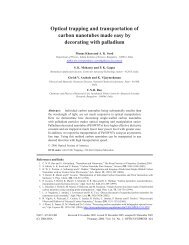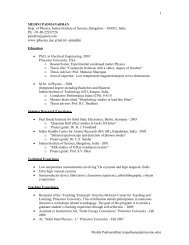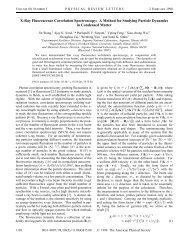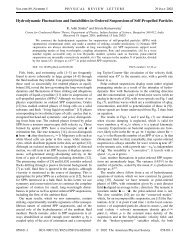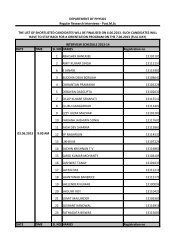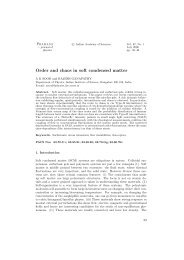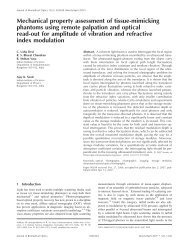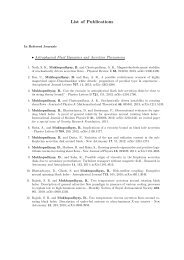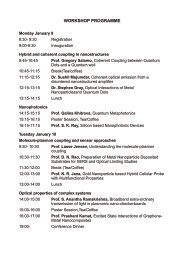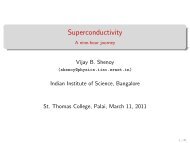Thermoelectric Properties of Fe0.2Co3.8Sb12-xTex ... - Physics
Thermoelectric Properties of Fe0.2Co3.8Sb12-xTex ... - Physics
Thermoelectric Properties of Fe0.2Co3.8Sb12-xTex ... - Physics
Create successful ePaper yourself
Turn your PDF publications into a flip-book with our unique Google optimized e-Paper software.
Low temperature electrical transport studies on carbon nitride<br />
films prepared by chemical vapour deposition<br />
M. Prashantha, E.S.R. Gopal and K. Ramesh ∗<br />
Department <strong>of</strong> <strong>Physics</strong>, Indian Institute <strong>of</strong> Science, Bangalore 560012, India.<br />
The search for new materials for advanced application leads to the discovery <strong>of</strong> new materials<br />
with interesting electrical, physical, chemical and mechanical properties. The advancement <strong>of</strong><br />
society and quality <strong>of</strong> human life also depends on these advanced materials. In this aspect<br />
carbon nitrides have been predicted to have high hardness, high wear resistance with low<br />
friction coefficient. These properties make them as a promising material for various<br />
applications such as organic semiconductors, fuel cells and photocatalysis, mechanical cutting<br />
tools, protective coatings, biomedical applications, electroluminescence devices, optical<br />
materials etc. The coating can reduce the wear, friction and corrosion, which can increase the<br />
life time and efficiency <strong>of</strong> the high speed moving parts. Carbon nitride coating is also found to<br />
be biocompatible. So, the successful synthesis <strong>of</strong> carbon nitride would have an enormous<br />
impact not only on the basic science but also on the technological development.<br />
In this work, we have attempted to prepare carbon nitride by chemical vapour deposition<br />
(CVD). We have used Azabenzimidazole (C 6 H 5 N 3 ) as the precursor which has both carbon<br />
and nitrogen bonding in its structure. In a two zone furnace, the vapours <strong>of</strong> the precursor<br />
evaporated at 450 o C in Zone I are made to enter into Zone II which is kept at high<br />
temperature. The vapours get pyrolysed and deposit on quartz and silicon substrates. The<br />
samples were prepared at different pyrolysis temperatures <strong>of</strong> 725, 750, 775, 800 and 825 o C.<br />
As the C-N bond is significantly strong, even at high temperatures a considerable amount <strong>of</strong><br />
C-N bonding is retained. This method is simple and enables one to have control over the<br />
amount <strong>of</strong> nitrogen in the system by controlling the pyrolysis temperature, volume <strong>of</strong> the<br />
liquid and the process time. The concentrations <strong>of</strong> N decreases gradually from 26 to 20 at %<br />
for the films prepared at pyrolysis temperatures <strong>of</strong> 725 to 825 o C.<br />
Electrical transport studies at low temperature (RT to 4.5K) show that the carbon nitride films<br />
exhibit Metal-Insulator (MI) transition. The incorporation <strong>of</strong> nitrogen into carbon introduces<br />
disorder in the structure. The disorder increases with the decrease <strong>of</strong> the nitrogen content,<br />
greatly influences the electrical transport properties. Disorder induced metal-insulator<br />
transitions are well known and can be studied by varying the temperature, pressure, doping<br />
level etc. In present study, metal insulator transition exhibited by carbon nitrides prepared at<br />
different pyrolysis temperatures has been studied. It is observed that the increase in pyrolysis<br />
temperature shifts the MI transition temperature to lower values. The transition temperatures<br />
for the samples prepared at 725 o C, 750 o C and 775 o C are 84.7 K, 67.7 K and 9.5 K<br />
respectively. The reduced activation energy indicates that the metallic regime <strong>of</strong> the samples<br />
prepared at pyrolysis temperatures > 800 o C lies at low temperatures. It is also observed that<br />
the activation energy decreases with the increase in pyrolysis temperature.<br />
∗ Corresponding author: kramesh@physics.iisc.ernet.in<br />
1



